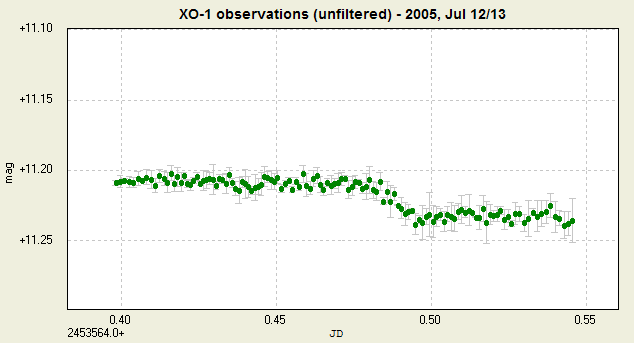 |
 |
 |
|
 |
| |
Co-discovery
of an exoplanet transiting XO-1
Early September 2004, I was the first amateur
astronomer to detect a transit
of exoplanet TrES-1b, after its discovery
announcement by professional astronomers. My
observations attracted quite some attention (see
e.g., Sky
& Telescope). One week after my TrES-1 observations,
I was contacted by astonomer Dr. Peter McCullough
from the Space Telescope Science Institute STScI,
who is the principal investigator of the NASA-funded
XO project, a photometric wide-field search for
Jovian planets transiting bright stars. Peter
invited me to join the project for photometric
follow up observations of suspected targets (see
below).
The Extended Team of the STScI XO Project
The XO Mark I observatory is located at Haleakala
(Hawaii), and hosts twin 200mm Canon EF200 lenses,
coupled with Apogee Ap8p CCD detectors, and mounted
on a Paramount ME equatorial mount. Each detector
covers a 7.2 degrees field on the sky. It monitors
tens of thousands bright stars (V < 12) twice
every 10 minutes on clear nights, for over 2 months
per season of visibility for each particular star.
It operates since September 2003.
Following my initial contacts with Peter
McCullough, a team of 4 amateur astronomers was
established, with as a main mission to assist with
the photometric follow up of candidates identified
in the XO data. Peter denoted this team the XO
Extended Team (E.T.). Members are Bruce L. Gary,
Peter J. Howell, Ron Bissinger and myself. We all
have previous experiences with CCD photometry of
exoplanets.
Candidate 240q31.634
In the months following my enrollment in the E.T.
team, I started monitoring several XO targets of
opportunity (TOO), that were selected by Peter
McCullough and his colleagues. Many of them turned
out to be false positives, or regular (unknown)
variables. One of the TOO's had code name 240q31.634,
and was intensively observed by our E.T. team in
June and July 2005. It quickly revealed a
'transit-like' signature (steep ingress and egress,
flanking a relatively wide flat bottom), and
evidently became one of the prime targets of our
observing campaigns.

Unfiltered observations of XO-1,
obtained at CBA Belgium Observatory on 2005, Jul
12/13,
using a 0.35-m f/6.3 telescope and ST-7XME CCD
camera.
The light curve shows part of a transit (ingress and
flat bottom).
Each dot in the light curve is an average of 3
observations. Error bars depict the standard
deviation.
On the basis of the E.T. light curves of 2005,
Peter and his colleagues acquired spectra of 240q31.634,
followed by additional photometry using a 1.8-m
telescope at Lowell Observatory, and using the E.T.
telescopes. Combining all available data, the XO
team concluded that 240q31.634 indeed was a star
hosting a transiting extrasolar planet, and the star
was designated XO-1. The discovery of
exoplanet XO-1b finally was announced in the Astrophysical
Journal. It clearly is the direct result
of a productive international collaboration between
professional and amateur astronomers. It is only the
second reported discovery of an exoplanet from a
telephoto-based wide-field survey, and the tenth
planet discovered using the transit method.
Below are multi-color (V and R) observations of
XO-1, that I obtained on 2006, Apr 06/07 at CBA
Belgium Observatory, by simultaneously using two
0.35-m f/6.3 telescopes, each equipped with a
ST-7XME CCD detector. The similarity between the V
and R light curve is obvious, except for the egress
part. It currently is unclear if this difference is
to be explained by a (so far) unknown physical
characteristic of XO-1, or if it's some kind of
observational artefact.

Observations of XO-1 obtained in V
(black dots) and R (red dots) at CBA Belgium
Observatory
on 2006, Apr 06/07, using two 0.35-m f/6.3
telescopes and ST-7XME CCD detectors.
XO-1b properties
XO-1 is a Sun-like G1V star in Corona Borealis,
also known as GSC 02041-01657. It's an 11-th
magnitude star at RA = 16h02m11.83s and Decl = +28°10'11.27"
(J2000.0). Of the ten stars currently known to host
extrasolar transiting planets, XO-1 is the most
similar to the Sun in its physical properties. It
has a radius of 1.0 +/- 0.08 solar radius, and a
mass of 1.0 +/- 0.03 solar mass. The orbital period
of the planet XO-1b is 3.941534 +/- 0.000027 days,
and the mass is 0.90 +/- 0.07 Jupiter's mass.
Websites of the XO-1b discoverers
http://hubblesite.org/news/2006/22
(Peter McCullough, STScI)
http://media.rice.edu/media/Default.asp
(Johns-Krull, Rice University)
http://www.bu.edu/phpbin/news/releases/display.php?id=1136
(Kenneth Janes, April Pinnick & Paul Howell,
Boston University)
http://www.ifa.hawaii.edu/info/press-releases/
(Peter McCullough & James Heasley, STScI; Bill
Giebink, Les Hieda, Jake Kamibayashi, Daniel
O’Gara, and Joey Perreira, Univ. Hawaii staff)
http://brucegary.net/X/x.htm
(Bruce L. Gary)
http://ronbissinger.home.comcast.net/favorite.htm
(Ron Bissinger)
http://www.howell-ltd.com/Astronomy/html/exoplanet.html
(Paul Howell)
|
| |
|
|
 |
|
 |
|
|
 |
Copyright © 2006 - Tonny Vanmunster.
|
 |
|
 |